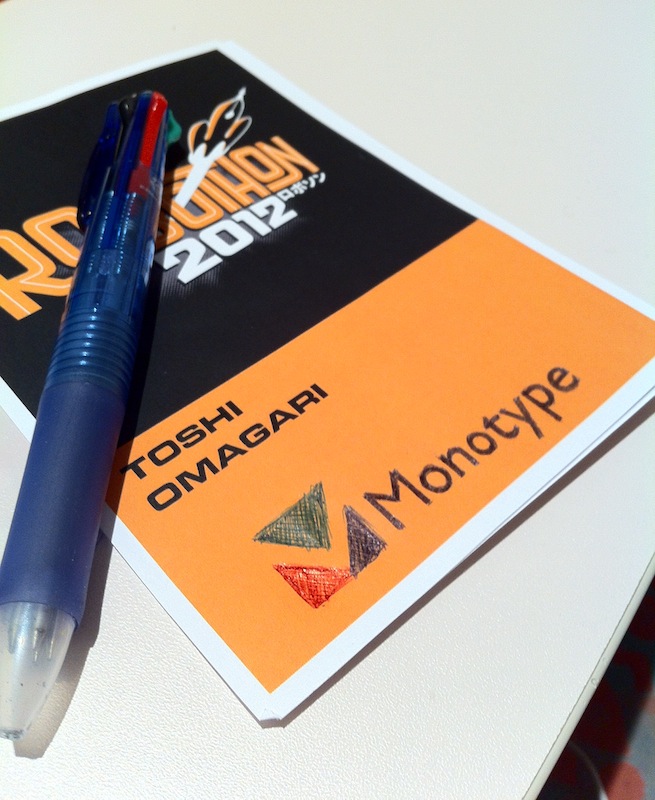RoboHint: the missing UFO hinter
09 March, 2012
The first serious job at Monotype is a trip to the Hague, to attend at Robothon 2012. I guess it’s unlikely that the new employee goes on a business trip in the first week, but somehow it happened to me (privilage!). Robothon is a really interesting conference as it focuses on typeface design and production process only. There’s a lot of interesting stuff going on in the Robofab and UFO circles which make me think want to get out of old school FontLab workflow as much as I want. Af all the things that were shown on the first day, the most interesting one was RoboHint, the missing UFO hinter being developed by Petr van Blokland.
[Update] Here’s the video of the presentation.
Petr gave an inspiring presentation. I wholeheartedly agree with him that hinting should be done by type designers themselves but not someone else, and that the hinting software should be as friendly as possible to designers. Although I enjoy TrueType hinting on FontLab very much and do think that it’s the best you can get, it’s far from perfect. With FontLab, most of the time I don’t have to deal with the text-based hinting and I can do what I want with GUI, however, the learning curve was wall steep and the interface was cryptic (but that’s FontLab). I believe it can be easier and more fun.
As far as I understood, Petr was trying to interpret the difficult TrueType parameters into something more understandable to us. The interface was still complex and many parameters were still edited in text but he said that he was trying to make something more powerful and easier than FontLab (that’s what I wanted to hear!). I am very curious to see how it will be improved.
But there’s another reason why I’m interested. During that talk, I saw a surprising screenshot. It was an ampersand being hinted with its outline UNmerged. Petr said in his talk that hinting has always been strangely the final step of typeface design and it could come into any point of already non-linear and complex interaction of other steps. The screenshot of hinted but unmerged outline illustrates his point, but how does that work when not all nodes are fixed yet?????? I did ask Petr about this, and he answered that it wouldn’t be a big problem as I thought and could be easily handled with the help of stable node ID featured in UFO3, and kept explaining in Klingon. So it may not be a matter.
If you compare punchcutting and digital typeface design, the equivalent of hinting in the former is a size expansion (cutting different sizes). Hinting is a size-specific type design in pixels which is partially automatic*. If you were a punchcutter and had to cut your typeface in ten different sizes, would you cut the uppercase A in ten different sizes and then B in ten different sizes, and then C, D…to z? No, you would get the first size (font) right then move on to nine others. That’s partly the reason why the hinting in digital type design comes at the latest stage too. But does it really have to be like that today? Why would you, as a designer, not want to take care of other sizes too but give it to someone else?
* The size-specific type design was originally done by hand and the bitmap image for each size had to be drawn and stored in the font filee. Now you don’t have to do that but you can just give an instruction to a renderer how to do it by indicating which part is important or not. That’s why it’s called hinting. Should it have been explained in the beginning?
Just in general, it took so much effort to go back to previous steps in the metal type making whereas now we constantly go back and forth between them. Strangely however, hinting (i.e. size expansion) was always at the end like in punchcutting. From a technical point of view this makes some sense regarding the overlapping outlines, but considering that all other steps got mixed in the design process, there’s no reason why hinting shouldn’t. I don’t see how hinting in the earlier stage will affect the design process, but that’s why RoboHint was the most interesting bit on the first day. This is also why RoboHint must be as friendly as possible to designers if Petr wants to make this happen.
But if he wants designers to mix up the processes, then why does he (and other designers of Robo-tools) separate them in separate apps (and sell them at sky-high prices)?
By the way, I was an indivudual atendee when I booked the ticket for the conference and the name tag didn’t mention the company, so I drew it myself. Clearly I’m over-excited to be one of them.
